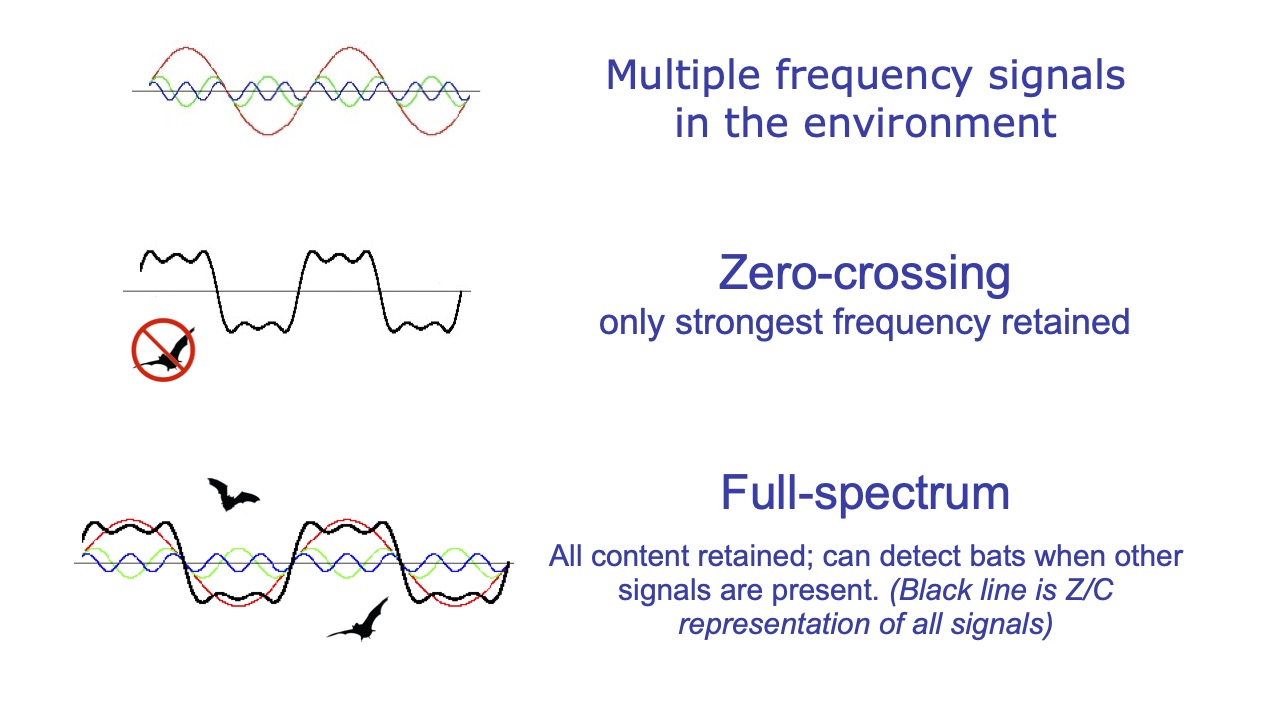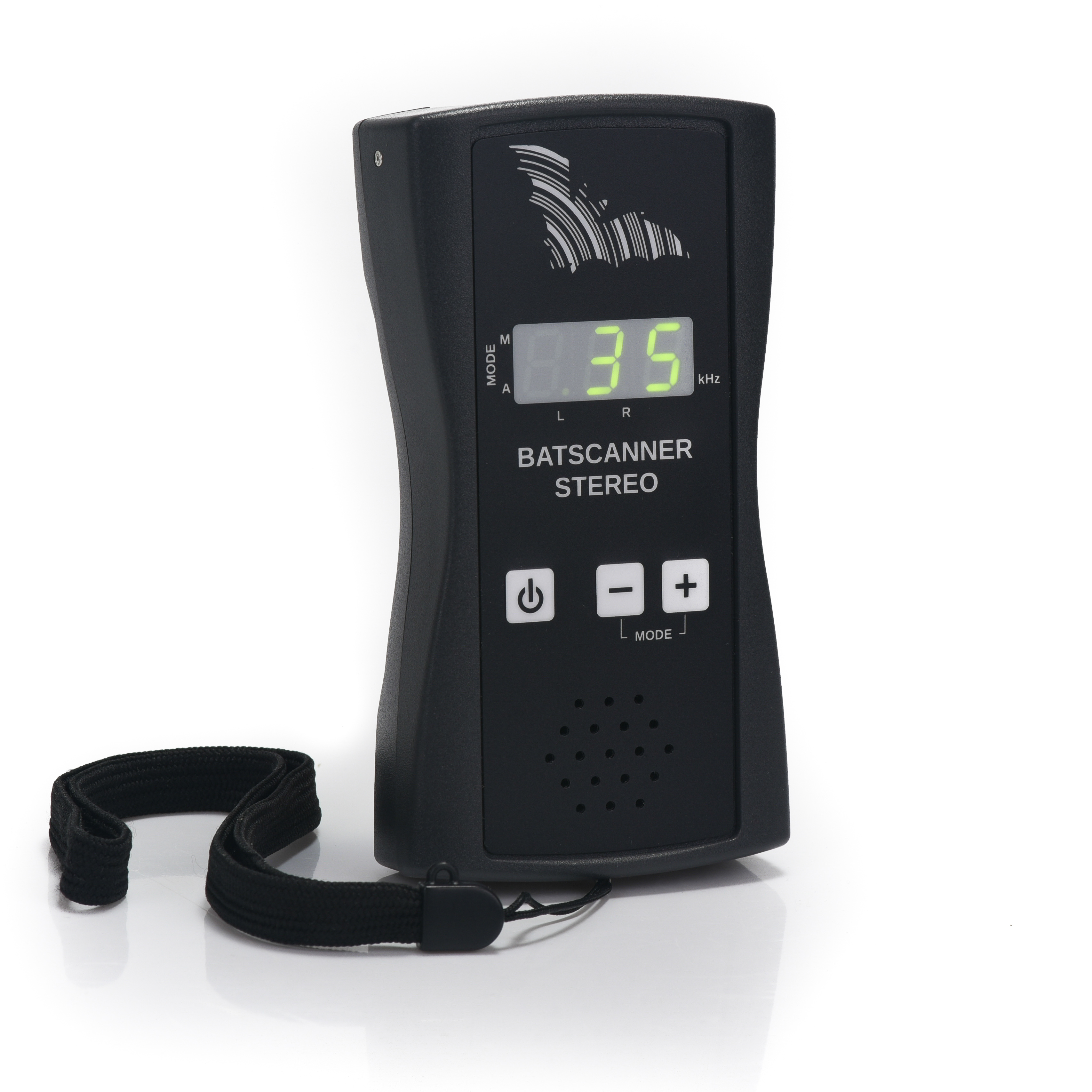When you review some of the 1,400+ bat species worldwide, a common thread is that many of them have disporportionally large ears. Therefore, it makes sense this may have something to do with navigating in the dark or catching prey.

In 1790 Italian Scientist Lazarro Spallanzani proposed that bats could “see” with their ears, but sadly he had no way to test his theory.
Spallanzani would not be vindicated until 1939 when Don Griffin documented echolocation in bats at his Harvard University physics lab.
The term "bat detector" is rather misleading. It is more properly should be called an "ultrasound detector", as most devices make little attempt to discern bats from all other ultrasound in the environment. This might include other animals besides bats, insects, leaves, wind, mechanical items, and electronics.

Due to the speed and frequency bats can make sounds, we have developed at least 4 ways to listen and study bat calls. Each method has important differences, and the approaches can compliment each other in that some detectors include more than one technology. The common types of bat detectors are full spectrum, frequency division, heterodyne, and zero cross. An additional "method" called "time expansion" is more of a feature of full spectrum and frequency division, rather than a technology in itself.

Most professional bat microphones today are recording the "full spectrum" of the bat's soundscape. This approach overcomes all data issues inherent with previous approaches. The only drawback is that the high data burden can require ~1 MB of space for every ~1 second of recording.
Full spectrum (FS) recordings consist of the entire bandwidth of all signals simultaneously, with no gaps in data, providing the most faithful representation of the ultrasoundscape possible.
Frequency Division (FD) is full spectrum recording but with less resolution. It contains amplitude and multiple frequency content but only the fraction of the temporal resolution, making it unusable for professional level analysis. However, it can display low-res spectragrams in real time, and can give a more complete picture than heterodyne-only devices.

Pettersson u256, u384, & M500
Available 256, 384 and 500 kHz sample rates, these full-spectrum microphones are the choice when live monitoring and recording bats using SonoBatLIVE or BatSound Touch. The u-series is designed to attach directy to certain smart devices for a compact recording solution.

Batbox Baton
The Baton is a super easy to use and inexpensive frequency division detector that can be used to monitor bats by itself, or attached to a laptop to view a live sonogram.

Pettersson D230
A combo heterodyne and frequency division detector. Using stereo headphones, you monitor the bat's full frequency range in FD in your right ear. When a bat arrives, quickly tune the HET (which you hear in your left ear) into the strongest signal. The frequency on the display will be where the bat's is calling the loudest, and is a huge step towards identification.
This "detector" tech really is a detector, origionally used to locate leaking pipes. The device actually generates it's own internal frequency you can select using a dial. The device combines that signal with the signal incoming from the microphone, which hopefully is a bat. When these signals are in sync, a "beat frequency" is generated. Very quickly you can "tune into" bats nearby, or just monitor a popular "bat channel" and you will hear a portion of the bat calls thru the speakers or headphones.
What we are really listening to is a bandwidth of 10 kHz centered on whatever frequency the HET dial is set to.
If the bat spends alot of time calling in your bandwidth, you’ll hear a long, lower pitched sound something like a "wet splooch". Dial it higher, and now you are listening to the high frequency part of the bat call, but the bat doesn't spend as much time calling in this frequency range, so you’ll hear what sounds more like a higher pitched fast paced "ticking".

Very quickly you can get quite alot of information from this device by listening carefully, tuning the device, and watching bat behavior. Just be aware you are only listening to a fragment of the bat call that you happen to have the device frequency set to.

Pettersson D100
A great advantage of heterodyne detectors like the D100 is that they are more sensitive; the D100 has dual microphones. They pick up bats at further distances than FS, FD, or ZC tech. They work out of the box; no fussing with smart devices, computers, or menus.
Humans cannot process sounds as fast as bats produce them. To use, all their calls sound like simple "ticks". Below is a recording of a Mexican freetail bat feeding buzz in real time, as it occurred. When this bat attacks an insect, it produces as many as 200 calls per second in the final fraction of a second before contacting a target. This is what to expect when listening to a bat passing by using any bat detector in real time. Play the video to appreciate how -fast- the animals are calling.
Some detectors and analysis software allows you to slow down the recording, so the human hear can hear the surprisingly rich tonal qualities of the bat sound. Below is the same recording of the Mexican freetail bat feeding buzz in the example above, but now slowed down 10x so you may actually -hear- the rich variation in the calls. Bat researchers use this technique (Time Expansion, or TE) to listen to the differences in bat calls, at the expense of it taking longer (a 2 second recording takes 20 seconds to listen to!) But, when playing recordings in this way, it is very easy to recognize multiple bats, social calls, and other noises in a recording.

Because the heterodyne approach yields call fragments, another method must be used to more fully record the call shapes. In 1987 Chris Corben invented the AnaBat, which was the first "detector" suitable for field which could also make recordings. Powerful computers required to make complete recordings were not field practical at the time, so Chris used a clever technique called "Zero Cross" to significantly reduce the data burden so computers of the day could keep up with the bats.

ZC devices are blind to signal strength. A very weak bat call plots the same as a very loud bat call. Out of range bat calls will plot only fragments of the loudest portion. When you have multiple signals hitting the microphone, the voltage is additive, which may distort or mask bat calls. ZC only represents the strongest signal present in the time slice. Most of the time this signal is your bat, but it could also be insects, environmential, or mechanical noise.

Incoming sound hits a diaphragm of a microphone that oscillates. That movement is converted into positive and negative voltage. ZC measures the time period it takes to make 8 oscillations (or "crosses the zero point"); this equals the average frequency during that count.
The average frequency of the loudest sound receives one point in every time slot on the display graph. This device is always looking for the loudest sound over the entire bat bandwidth simultaneously, so this provides a view of the overall bat call shape, rather than just fragments such as found with heterodyne.





